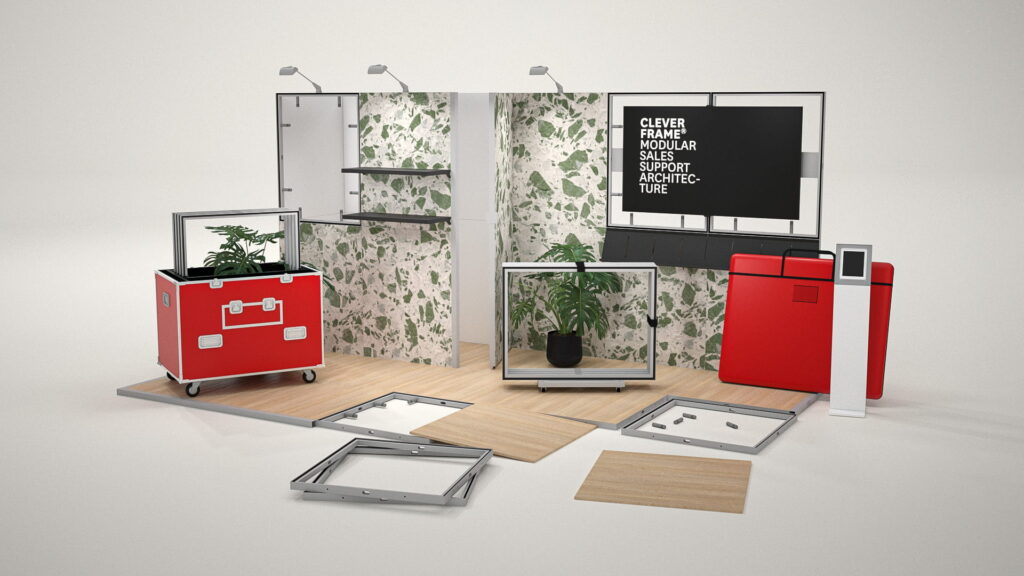A carbon footprint is the total amount of greenhouse gas emissions, especially carbon dioxide (CO2), generated by an activity, product, or service. In the context of trade shows, the carbon footprint includes all emissions associated with transport, stand construction, operation, and disposal after the event. With growing environmental awareness, more companies are looking for solutions that help reduce their impact on the planet – including at exhibitions and trade fairs.

So, how can you effectively lower CO2 emissions related to trade show participation? What solutions does Clever Frame offer that support the reduction of exhibition stand carbon footprints? Explore practical insights that will help make your trade show presence more sustainable.
Participating in trade shows generates significant CO2 emissions. Transporting materials, stand build-up and dismantling, and producing disposable elements – all these activities contribute to greenhouse gas emissions. Reducing your carbon footprint benefits not only the environment but also your business:
The foundation of reducing your trade show carbon footprint lies in choosing the right stand technology. The Clever Frame modular exhibition system is designed for long-term, repeated use – significantly cutting waste generation and CO2 emissions.
Unlike traditional one-off solutions that end up in landfills after each event, Clever Frame systems can be reused for years. How does this help lower emissions?
The system is built from aluminum frames and connectors, ensuring exceptional durability. The same components can be used for multiple events, year after year. This eliminates the need for producing new structures for every show, directly reducing emissions related to manufacturing.
Reusability is one of the strongest drivers of carbon footprint reduction. Research shows that modular, reusable systems can cut CO2 emissions by up to 70% compared to single-use stands.
How to adapt your stand to different events without generating excess waste? The Clever Frame magnetic system enables quick panel replacement, letting you update graphics for seasonal campaigns or marketing trends – without changing the entire structure.
Thanks to its modular design, you can:
Transporting materials is one of the largest contributors to a trade show’s carbon footprint. Clever Frame systems are designed to minimize environmental impact during logistics.
Clever Frame components are engineered to take up minimal space in transport. Lightweight aluminum frames significantly reduce CO2 emissions compared to traditional, heavy trade show constructions.
Did you know? Reducing transported material weight by just 100 kg can lower emissions by about 30 kg over a 1,000 km distance. The lightweight Clever Frame system ensures easier assembly and a smaller carbon footprint.
The system includes durable, reusable transport crates that eliminate the need for disposable packaging. These protective containers ensure safe transport and can be used for many years – reducing packaging waste to zero.
Reducing your carbon footprint goes beyond the stand structure itself – it also involves managing resources during the event. How can you minimize waste generation?
Replacing traditional printed materials with digital equivalents is a simple way to cut your footprint. Clever Frame stands allow seamless integration of digital solutions such as:
Digitalization not only reduces paper usage but also cuts emissions linked to printing and transporting marketing materials.
Choosing the right partners and suppliers is crucial for lowering your carbon footprint at trade shows. Clever Frame works with suppliers that share sustainable values.
Clever Frame systems are manufactured locally, reducing emissions from long-distance shipping. Aluminum used in frames is fully recyclable, which further reduces environmental impact compared to producing new raw materials.
Collaborating with local event service providers – such as catering or technical support – also helps reduce transport-related emissions.
At the end of their lifecycle, Clever Frame components can be recycled or upcycled. Since aluminum is 100% recyclable, the system remains eco-friendly even after years of use, ensuring it never becomes a burden to the environment.
To successfully lower your footprint, it’s worth measuring and monitoring it. How can you do this?
Compare the CO2 emissions generated by a traditional one-off stand with those from a Clever Frame system. Consider:
Sharing your carbon footprint reduction results can become part of your company’s marketing strategy – highlighting your commitment to sustainability.
Choosing the Clever Frame modular exhibition system is a step toward greener trade show participation. Environmental benefits include:
Reducing your trade show carbon footprint is not only about protecting the environment but also about business efficiency and brand image. By choosing Clever Frame, you invest in a solution that supports your sustainability strategy while ensuring effective trade show marketing.
Clever Frame reduces emissions through reusability – the same components can be used for multiple events, eliminating the need for producing new materials each time. Lightweight aluminum design lowers transport emissions, while magnetic graphic panels reduce waste. At the end of their lifecycle, all components are fully recyclable.
Yes. Research shows that reusable modular stands can cut carbon footprints by up to 70% compared to single-use structures. The main savings come from eliminating constant material production and reducing post-event waste. Clever Frame, designed for repeated use across many events, is a sustainable alternative to disposable solutions.
In addition to using the Clever Frame modular system, you can reduce your carbon footprint by:
– Working with local service providers to limit transport emissions
– Switching to digital materials via QR codes instead of print
– Using energy-efficient LED lighting
– Planning logistics to minimize transport trips
– Training stand staff in sustainable practices such as proper waste segregation